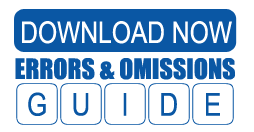McGowanPRO
What are insurance underwriters looking for in an investment advisor’s application for errors & omissions (aka professional liability) insurance?
Download the comprehensive 33-page Guide to gain:
– Clarity to the Insurance Evaluation Process
– Specific Guidance and Roadmap to Improved Outcomes
– Risk Management Resources for your Practice
The Investment Advisor's Guide to Errors & Omissions Insurance
An exclusive guide to the Errors & Omissions Insurance Application for Investment Advisors and Financial Professionals
 By Gary Sutherland, CIC, MLIS
By Gary Sutherland, CIC, MLIS  By Paul Smith, AIF
By Paul Smith, AIF
What are insurance underwriters looking for in an investment advisor’s application for errors & omissions (aka professional liability) insurance?
It is a question that we are often asked, and due to the complexity of the risk, the answer is never simple. Applicants’ unique risk characteristics are not always apparent – even to themselves.
The Investment Advisor’s Guide to Errors & Omissions Insurance adds clarity to the evaluation process, offers guidance, and where possible, a roadmap to improved outcomes.
The Guide is divided into nine chapters available here:
3. Claims, Fines and Sanctions
4. Discretionary Versus Non-discretionary
6. Assets Under Management (AUM)
8. Custodian of Funds and Lost Accounts
9. Areas of Practice Unrelated to Financial Advising
The Investment Advisor’s Guide to Errors & Omissions Insurance will help you anticipate areas of underwriter concern as it relates to your specific investment practice, helping you internally evaluate your risk exposures and better define your activities and professional services.
In several chapters we have offered our opinions which are based on 20-plus years of negotiating insurance coverages and working in the investment advisory space. Naturally, we cannot promise that all insurance carriers follow the same guidelines – or treat similar information uniformly – as we make clear in the following pages.
We have tried to anticipate questions – from the most basic to the more nuanced – while digging deeper into the prevailing wisdom of current underwriting concerns and carrier tendencies. We will update this guide as newly-defined and evolving risk exposures find their way into our applications.
The object of this guide is neither based solely on the reduction of premium or pricing, nor does it suggest altering your application in any way that is not 100% accurate to circumvent the concern of adverse underwriting. (Because doing so could potentially void coverage.) It is critically more important to make sure coverage is correct and exposures are covered without gaps; or any deficiencies are understood and assessed appropriately.
At the end of the day, understanding the nature of your firm’s practice, and translating that clearly in the application process, is the key to placing your errors & omissions coverage with a well-matched carrier that will provide best in class protection at premium pricing that appropriately fits your risk exposures.
Contact us for additional information:
Gary Sutherland, MLIS, CIC Garys@mcgowanprofessional.com 508-656-1350

